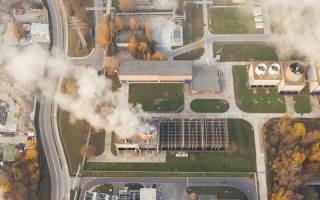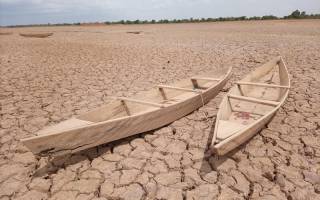Climate change not only impacts our external environment, but also has a big impact on global public health issues.
Find out more on how climate change affects the air we breathe, the food we eat and much more.
Delivering a Net-Zero NHS

- What is the NHS's Net-Zero Strategy?
- Why does the NHS need to achieve Net-Zero?
- How will the NHS set to achieve Net-Zero?
- What about Covid-19?
Air Pollution Affect Our Health?

Heatwaves and Health

- Is the earth warming
- How does global warming directly affect human health?
- How does global warming indirectly affect us?
- What should the public do?
How Sustainable Is Your Food?

Delivering a Net-Zero NHS
What is the NHS’s Net-Zero Strategy?
On the 1st October 2020, the NHS became the world’s first health organisation to commit to reaching net zero by 2040. In order to achieve this ambitious plan to eliminate its greenhouse gas emissions produced by vehicles, buildings and services ¹. 30 trusts were allocated a combined total of £260m ².
Why does the NHS Need to Achieve Net-Zero?
The climate crisis is a health crisis. The situation is only getting worse, with almost 900 people killed by record heat waves in England in 2019 alone. As England’s largest employer, the NHS must do more to reduce the 4% of England’s emissions it is currently responsible for.
Without immediate action, it is predicted that there will be more storms, flooding, intense heat waves and a faster spread of infectious diseases. Given the direct consequences on patients and the wider public, the plan for a greener NHS was consequently developed ².
How will the NHS Set to Achieve Net-Zero?
The entire NHS must act for net zero to successfully be achieved. The 2020 Net-Zero identified eight key areas for decarbonisation with several suggestions including:
Care Provision
Implementing sustainable models of care by boosting ‘out-of-hospitals’ services will not only improve patient treatment but also save approximately 8.5 million lm of unnecessary travel per year (to and from hospitals).
Medicines and supply chains
Interventions include introducing low carbon inhalers, lowering anaesthetic gases, improving production and better regulating waste processes should help to reduce the 25% of emissions that medicines currently account for in the NHS.
Transport and Travel
Electrifying NHS transport, conducting green fleet reviews, incentivising staff to use eclectic vehicles and supporting staff to choose sustainable methods of transport for their commute have all been suggested as necessary and realistic targets.
Innovation
Net-zero will be incorporated into the NHS’ research strategy, with all applicants to national innovation support programmes required to consider the environmental impact of possible products and services.
Hospitals
Use of artificial intelligence is also suggested in order to monitor real-time energy consumption and control. All new hospitals and buildings should be net zero compatible and be constructed using innovative, low-carbon materials.
Heating and Lighting
Existing hospital sites can be upgraded through engineering solutions including use of 100% LED lighting and on-site renewable energy and heat generation.
Adaptation Efforts
Resilience and adaptation will be at the forefront of this Net-zero strategy. For example, all new hospitals will have a new design that allows for flexibility when considering how models of care will shift in the future.
Values and Governance
Ensuring that every NHS organisation has a board level net zero lead, with emphasis that this is a key responsibility for all staff.
What about COVID-19?
In order to maintain high quality care and service provision, the unprecedented demand for PPE during the first COVID-19 peak put strain on global supply chains. Given that such items are mostly single-use and made of plastic, the environmental impact this has had is of increasing concern. Made-for-reuse PPE items are currently being developed but have not yet been implemented.
More promisingly, the response to COVID-19 rapidly accelerated a digital low-carbon transformation, with outpatient and primary care appointments shifting to a more accessible, online format. High levels of video consultations have since been put in place in GP practices and adult mental health services. However, given that current evidence is preliminary, more data is needed from a wider range of services across a longer duration of time to provide a comprehensive analysis of these virtual services ¹.
References
- Greener NHS. ‘Delivering a Net Zero National Health Service’.
- Limb, M. ‘Trusts need support to help NHS meet zero ambitions, say leaders’.
Heatwaves and Health
Is the Earth warming?
Yes. The earth has warmed by 1°C since the pre-industrial era and two-thirds of this rise has occurred since 1986 ¹. There is a linear relationship between greenhouse gas emissions and atmospheric warming.
When we burn fossil fuels, like coal and gas, we release carbon dioxide (CO2) ¹. CO2 builds up in the atmosphere and causes Earth’s temperature to rise.
Increases in the overall temperature of the atmosphere causes changes in wind, moisture, and heat circulation patterns, which can contribute to shifts in extreme weather events, including extreme heat events.
How does global warming directly affect human health?
Extended periods of high day and night time temperatures create cumulative physiological stress on the human body which exacerbates the top causes of death globally, including respiratory and cardiovascular diseases, diabetes mellitus and renal disease ².
Heat stroke is the most serious heat-related disorder ¹. It occurs when the body is unable to control its temperature. During heat stroke, body temperature rises, the sweating mechanism fails, and the body cannot cool down, leading to death or permanent disability. Higher temperatures and respiratory problems are also linked. One reason is because higher temperatures contribute to the build-up of harmful air pollutants ¹.
The elderly, infants and children, pregnant women, outdoor and manual workers, athletes, and the poor have an increased risk of death from exposure to excess heat ².
How does global warming indirectly affect us?
On agriculture: some crops require cool night temperatures, current predictions estimate that global warming of 2°C (two degrees Celsius), as in the most optimistic forecast, could reduce agricultural output by up to 25% ³. Rural communities who live in tropical climates will be particularly vulnerable as their livelihoods are more reliant on agriculture.
On energy: higher summer temperatures increase electricity demand for cooling, and it also can lower the ability of transmission lines to carry power, possibly leading to electricity reliability issues during heat waves ⁴. As rivers and lakes warm, their capacity for absorbing waste heat from power plants declines, which reduces the thermal efficiency of power production ⁴.
What should the public do?
Stay cool. Open all windows and shutters during the night and the early morning, when the outside temperature is lower. Close windows and shutters (if available) especially those facing the sun during the day. Turn off artificial lighting and as many electrical devices as possible. If your place has air conditioning, close the doors and windows and conserve electricity not needed to keep you cool ².
Stay out of the heat. Avoid going outside during the hottest time of the day. Avoid strenuous physical activity if you can. If you must do strenuous activity, do it during the coolest part of the day, which is usually in the morning between 4:00 and 7:00. Stay in the shade. Do not leave children or animals in parked vehicles ².
References
- Centers for Disease Control and Prevention, C.D.C., Extreme Heat Can Impact Our Health In Many Ways.
- World Health Organisation, Heat and Health.
- VoxDev, How do farmers cope with extreme heat?
- Center for Climate and Energy Solutions, Heat Waves and Climate Change.
How Does Air Pollution Affect Our Health?
Does global warming lead to air pollution?
Air pollution both drives climate change and can also be exacerbated by climate change ¹. Short-lived climate-forcing pollutants (SLCPs) warm the Earth, and include methane, black carbon, ground-level ozone, and sulfate aerosols ².
Higher temperatures lead to an increase in allergens and harmful air pollutants, which is associated with many health problems, including diminished lung function, increased hospital admissions and emergency department visits for asthma, and increases in premature deaths ¹.
More and larger wildfires linked to climate change can also significantly reduce air quality. Smoke exposure increases acute (or sudden onset) respiratory illness, respiratory and cardiovascular hospitalizations, and the frequency of wildfires is expected to increase as drought conditions become more prevalent ¹.
What is air pollution?
There are 2 main types of air pollution; smog (sometimes referred to as ground-level ozone) which occurs when emissions from burning fossil fuels react with sunlight, and soot (also known as particulate matter) which is made up of tiny particles of chemicals, soil, smoke, dust, or allergens. Both smog and soot have similar sources; cars, factories, power plants, and engines ³.
What is the effect of air pollution on human health?
Short term effects include asthma attacks, coughing, wheezing and shortness of breath. Longer-term effects include increasing the risk of stroke, lung cancer, and cardiovascular disease ⁴. Effects can be even worse for people who have asthma or allergies: these extra pollutants can intensify their symptoms.
Because motorways and polluting facilities have historically been located in or next to low-income neighborhoods and communities of color, the negative effects of this pollution have been disproportionately experienced by the people who live in these communities ³. Other groups disproportionately affected include older people, children, pregnant women, individuals with existing medical conditions ⁴.
What can we do?
- Wear sunscreen. When ultraviolet radiation comes through the weakened ozone layer, it can cause skin damage and skin cancer ³.
- Active modes of transport like biking or walking can help reduce traffic-related air pollution and encourage physical activity, which has public health benefits including reduced rates of obesity, heart disease, and diabetes ¹.
- People with asthma/pollen allergies can limit their outdoor exposure on days with a high pollen count ¹.
- If you exercise outside, stay as far as you can from heavily trafficked roads. Then shower and wash your clothes to remove fine particles ³.
References
- Centers for Disease Control and Prevention, C.D.C., Climate Change Decreases the Quality of the Air we Breathe.
- Institute for Advanced Sustainability Studies, Air Pollution and Climate Change.
- NRDC, Air Pollution: Everything You Need to Know.
- Public Health England. Health Matters: Air pollution – sources, impacts and action
How Sustainable Is Your Food?
Everyone needs to eat. But how often have you really thought about where your food comes from and how sustainable it really is?
What are Factory Farms?
Factory farming serves an increasing demand for meat and dairy products, quickly and cheaply. It was introduced in order to feed an increasing population, with less energy and time. But in reality for every 100 food calories of edible crops fed to livestock, we get back just 17 calories in the form of meat and dairy; an 83% loss ¹.
What’s the Problem With Factory Farms?
Keeping animals caged, cramped and crowded provides the perfect environment for diseases to spread rapidly. Conditions in factory farming are inherently inhumane towards animals, bordering on animal abuse.
Artificial selection for specific traits in animals e.g. chickens with bigger breasts has led to unnatural genetic manipulation of animals, leading to a host of medical issues for the animals. Additionally, large numbers of genetically similar animals, allow diseases to spread much faster. These animals are already vulnerable to ‘’superbug’’ infections from antibiotic resistance, as they are fed large amounts of antibiotics, so that they can survive in the stressful conditions of factory farming ².
Pollution from factory farms in the air, rivers and land nearby can lead to particularly dangerous human health issues, which disproportionately affect poorer, minority communities ². Smaller, family farms have difficulty in competing with larger factory farms, as they cannot match the low prices and high volumes that factory farms are able to achieve
What is Sustainable Agriculture and Why is It Better for the Environment?
The core principle of sustainable agriculture is to meet present food and textile needs without compromising the ability of future generations to meet their own needs ³. Techniques used include crop rotation, polyculture farming, permaculture, crop diversity, agroforestry and biodynamic farming ⁴. Studies show that this production strategy uses up to 56% less energy per unit of crops produced, supports greater levels of biodiversity than conventional farming and creates 64% fewer greenhouse gas emissions per hectare ⁵
Why isn’t Sustainable Farming the Global Gold-Standard?
One of the key challenges is making consumers care about how their dietary choices can impact the environment, their own health or farming practices. This complex intersection is often not considered by policymakers where nature is not viewed as a form of capital. Accordingly, legislation is typically not designed to protect against environmental degradation. Without consumer demand or legal obligations, producers have little incentive to change their own production strategies ⁶.
What Role Do I Have as a Consumer?
In order to ensure a future of food security for a rapidly growing world population, it is important to understand that everyone has a role to play. According to the 2013 WRI report, it is estimated that by 2050, food production will need to increase by at least 70% to meet global requirements.
As a consumer, there are several changes you can make in order to ensure a more sustainable future including reducing food waste (e.g., by composting or reinventing left-overs), growing your own fruits and veggies and choosing to buy organic where possible (Gould, 2014).
However, evidence indicates that a vegan diet is possibly the best way to reduce your carbon footprint and can tackle issues such as eutrophication, improper land use and overuse of water ⁷.
References
- Compassion in World Farming. Ending Factory Farming
- The Human League, Factory Farming: What it is and Why it’s a Problem.
- Brodt, S., Six, J., Feenstra, G., Ingels, C. & Campbell, D. Sustainable Agriculture. Nature Education Knowledge. 2011 3(10):1.
- Conserve Energy Future. ‘What Is Sustainable Farming’.
- UNEP, ITC and ICTSD; ‘Trade and Environment Briefings: Sustainable Agriculture’; ICTSD Programme on Global Economic Policy and Institutions; Policy Brief No. 3; International Centre for Trade and Sustainable Development, Geneva, Switzerland. 2012.
- Gould, H ‘10 things you need to know about sustainable agriculture’. The Guardian.
- Poore, J, Nemecek, T. Reducing food’s environmental impacts through producers and consumers. Science. 2018; 360 (6392): 987-992.
 Close
Close

